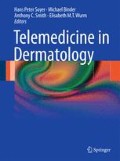Abstract
Teledermatology can facilitate access to high-quality, cost-effective health care in developing countries, as well as play an essential role in clinician education, foster distribution of educational materials, and promote independence in clinical practice as well as improving patient care.
Access this chapter
Tax calculation will be finalised at checkout
Purchases are for personal use only
References
Charles M, Boyle B (2002) Excess and access: the continuing controversy regarding HIV and health care in Africa. AIDS Read 12:288–292
Worldmapper. Physicians working. Map No. 219. Available at: accessed on Oct 4, 2009 http://www.worldmapper.org/display.php?selected=219
International Foundation for Dermatology (IFD) About IFD: Who needs our help? Available at: accessed on Oct 4, 2009 http://www.ifd.org/about2.html
Morrone A (2007) Poverty, health and development in dermatology. Int J Dermatol 46(Suppl 2):1–9
Schmid-Grendelmeir P, Doe P, Pakenham-Walsh N (2003) Teledermatology in sub-Saharan Africa. Curr Probl Dermatol 32:233–246
Indian Association of Dermatologists, Venerologists and Leprologists (IADVL) Welcome to IADVL. accessed on Oct 4, 2009 http://www.iadvl.org/site/?q=node/14
Figueroa JI, Fuller LC, Abraha A et al (1996) The prevalence of skin disease among schoolchildren in rural Ethiopia: a preliminary assessment of dermatologic needs. Pediatr Dermatol 13:378–381
Aas IH (2002) Learning in organizations working with telemedicine. J Telemed Telecare 8(2):107–111
Shaikh N, Lehmann C, Kaleida P et al (2008) Efficacy and feasibility of teledermatology for paediatric medical education. J Telemed Telecare 14:204–207
World Bank (2006) Disease control priorities project: skin diseases. The World Bank Web Site: http://www.dcp2.orq/pubs/DCP/37/FuIiText. Updated 2006. Accessed 20 Sept 2008
Kaddu S, Kovarik C, Gabler G et al (2009) Teledermatology in developing countries. In: Wootton R, Patel N, Scott R, Ho K (eds) Telehealth in the developing world. Royal Society of Medicine Press/IDRC, London, pp 112–124
Myers MR (2003) Telemedicine: an emerging health care technology. Health Care Manag 22:219–223
Dill S, Digiovanna J (2003) Changing paradigms in dermatology: information technology. Clin Dermatol 21:375–382
Wootton R, Oakley AM (2002) Teledermatology. Royal Society of Medicine Press Ltd, London
Ebner C, Wurm EM, Binder B et al (2008) Mobile teledermatology: a feasibility study of 58 subjects using mobile phones. J Telemed Telecare 14:2–7
Lim AC, Egerton IB, See A et al (2001) Accuracy and reliability of store-and-forward teledermatology: preliminary results from the St George Teledermatology Project. Australas J Dermatol 42(4):247–251
Eedy DJ, Wootton R (2001) Teledermatology: a review. Br J Dermatol 144:696–707
High WA, Houston MS, Calobrisi SD et al (2000) Assessment of the accuracy of low-cost store-and-forward teledermatology consultation. J Am Acad Dermatol 42:776–783
Rashid E, Ishtiaq O, Gilani S et al (2003) Comparison of store and forward method of teledermatology with face-to-face consultation. J Ayub Med Coll Abbottabad 15(2): 34–36
Lepe V, Moncada B, Castanedo-Cázares JP et al (2004) First study of teledermatology in Mexico: a new public health tool. Gac Med Mex 140(1):23–26
Trindade MA, Wen CL, Neto CF et al (2008) Accuracy of store-and-forward diagnosis in leprosy. J Telemed Telecare 14(4):208–210
Caumes E, Le Bris V, Couzigou C et al (2004) Dermatoses associated with travel to Burkina Faso and diagnosed by means of teledermatology. Br J Dermatol 150:312–316
Kaliyadan F, Venkitakrishnan S (2009) Teledermatology: clinical case profiles and practical issues. Indian J Dermatol Venerol Leprol 75(1):32–35
African Teledermatology Project: accessed on Oct 4, 2009 http://africa.telederm.org/
Chung P, Yu T, Scheinfeld N (2007) Using cellphones for teledermatology, a preliminary study. Dermatol Online J 13(3):2
Swinfen Charitable Trust Website: accessed on Oct 4, 2009 www.swinfencharitabletrust.org
Kaddu S, Soyer P, Gabler G et al (2009) The Africa Teledermatology Project: preliminary experience with a sub-Saharan teledermatology and e-learning program. J Am Acad Dermatol 61(1):155–157
Proyecto Latinoamericano de Teledermatología: accessed on Oct 4, 2009 http://latinoamerica.telederm.org/default.htm
Amazonas-Brazil teledermatology and teledermatopathology project: accessed on Oct 4, 2009 http://piel.telederm.org.
Kanthraj GR, Srinivas CR (2007) Store and forward teledermatology. Indian J Dermatol Venereol Leprol 73(1):5–12
Bagchi S (2006) Telemedicine in rural India. PLoS Med 3(3):e82
Bhaskaranarayana A, Satyamurthy LS, Remilla M (2009) Indian Space Research Organization and telemedicine in India. Telemed J E Health 15(6):586–591
Indian Space Research Organization (ISRO) Telemedicine: accessed on Oct 4, 2009 http://www.isro.org/scripts/telemedicine.aspx
Telemedicine: Online support for HIV/AIDS care: accessed on Oct 4, 2009 telemedicine.itg.be/telemedicine/site/Default.asp
Teledermatology South Africa: accessed on Oct 4, 2009 http://faculty.washington.edu/rcolven/teledermatology.shtml
Operation Village Health: accessed on Oct 4, 2009 http://www.connected-health.org/programs/remote-consultations/center-for-connected-health-models-of-care/operation-village-health.aspx
Brauchli K, O’Mahony D, Banach L et al (2005) iPath – a telemedicine platform to support health providers in low resource settings. Stud Health Technol Inform 114:11–17
ipath Association Home page. Available at: accessed on Oct 4, 2009 http://ipath.ch/site/en/verein
Solomon Islands Telemedicine Network: accessed on Oct 4, 2009 telemed.ipath.ch/solomons
LT Telepatologija – Lithuania: accessed on Oct 4, 2009 ipath.ch/site/node/441. Also, in Lithuanian, at: telemed.ipath.ch/lithuania
RAFT: accessed on Oct 4, 2009 raft.hcuge.ch
Telemedicina Sur: accessed on Oct 4, 2009 telemed.ipath.ch/tmsur
West Africa Doctors and Healthcare Professionals Network: accessed on Oct 4, 2009 www.wadn.org
HealthNet Nepal: accessed on Oct 4, 2009 www.healthnet.org.np
Teledermatology in Port St Johns, South Africa: accessed on Oct 4, 2009 ipath.ch/site/node/22
Click Diagnostics: accessed on Oct 4, 2009 http://www.clickdiagnostics.com/index.html
Tsai HH, Pong YP, Liang CC et al (2004) Teleconsultation by using the mobile camera phone for remote management of the extremity wound: a pilot study. Ann Plast Surg 53:584–587
Whited J (2006) Teledermatology research review. Int J Dermatol 45:220–229
Author information
Authors and Affiliations
Corresponding author
Editor information
Editors and Affiliations
Rights and permissions
Copyright information
© 2012 Springer-Verlag Berlin Heidelberg
About this chapter
Cite this chapter
Weinberg, J., Kaddu, S., Kovarik, C. (2012). Teledermatology in Developing Countries. In: Soyer, H., Binder, M., Smith, A., Wurm, E. (eds) Telemedicine in Dermatology. Springer, Berlin, Heidelberg. https://doi.org/10.1007/978-3-642-20801-0_6
Download citation
DOI: https://doi.org/10.1007/978-3-642-20801-0_6
Published:
Publisher Name: Springer, Berlin, Heidelberg
Print ISBN: 978-3-642-20800-3
Online ISBN: 978-3-642-20801-0
eBook Packages: MedicineMedicine (R0)

